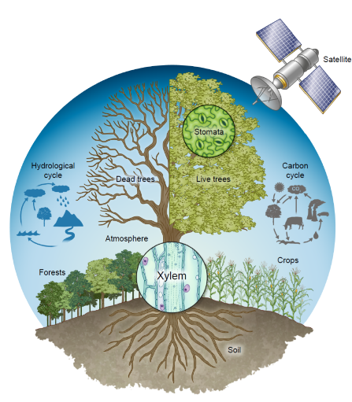The Science
Plant hydraulics has evolved dramatically in the last century, leading to knowledge of critical value to agriculture, forest management, and global modeling. Here we review these developments and highlight some of the critical new directions for plant hydraulics in the 21st century.
The Impact
Plant hydraulics is the backbone of terrestrial ecology because of the critical role of water transport in regulating carbon uptake. We highlight the impacts plant hydraulics have had on fields ranging from agricultural management to the terrestrial carbon and water cycles, and propose the path forward to new insights of value to both fundamental and applied sciences.
Summary
Plant hydraulic regulation of water uptake provides the backbone of the plant carbon cycle and ecology because of its direct control over, and tight coordination with, canopy photosynthesis. Advances in measurements and modeling over the last few decades have enabled far-reaching influence of hydraulic discoveries, including impacting how we view and simulate the global water and carbon cycles and manage crop systems (Figure 1). Perhaps most importantly in this era of a warming atmosphere and more variable droughts, is the critical role our understanding of plant hydraulics is having on our ability to predict and mitigate chronically-increasing stressors (e.g. temperature, vapor pressure deficit) on plant function and survival. The 21st century offers a very exciting time for advancement of plant hydraulics understanding, approaches, and applications. Future directions range in scale from understanding the molecular regulation and feedbacks with maximum conductance and embolism avoidance, to improved understanding of water potential regulation at landscape to global scales. Inherently, developments in understanding will be associated with continued methodological improvements at micro- to macro-scales, and with applications of refined hydraulic models to allow strong, process-based inferences. Perhaps the most important directions that plant hydraulics science can go is in applications to the prediction and management of both wild and crop systems under rising temperature and vapor pressure deficit and drought frequency, which threatens food production and the global carbon cycle alike.

Contacts (BER PM): Daniel Stover, SC-23.1, Daniel.Stover@science.doe.gov (301-903-0289)
PI Contact: Nate McDowell, PNNL, nate.mcdowell@pnnl.gov
Funding
DOE-NGEE Tropics
Publications
McDowell NG, T Brodribb, A Nardini (2019). Plant hydraulics in the 21st century. New Phytologist doi.org/10.1111/nph.16151.